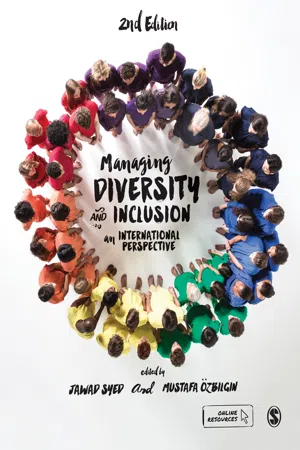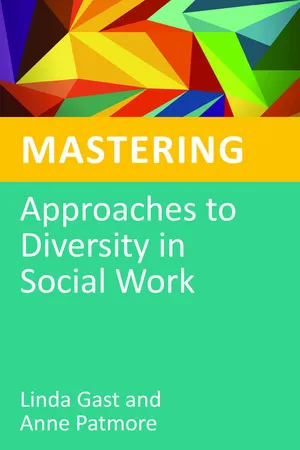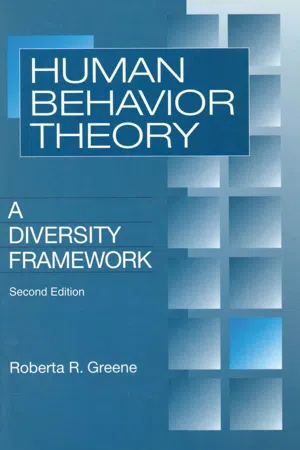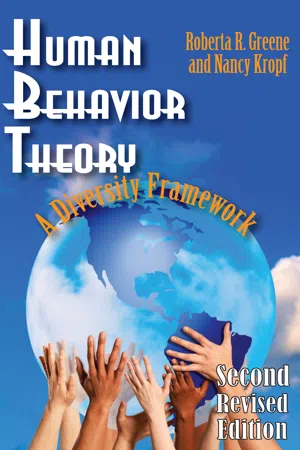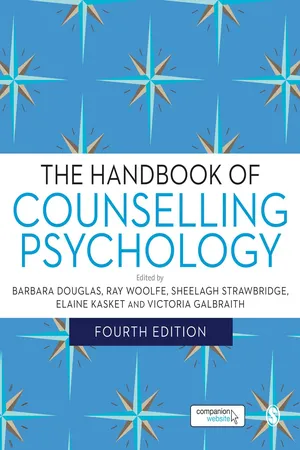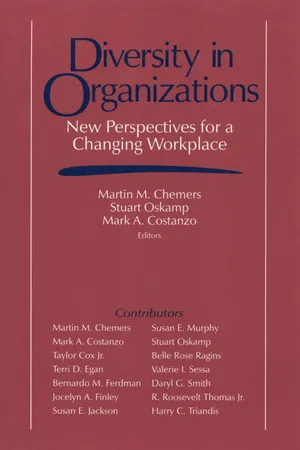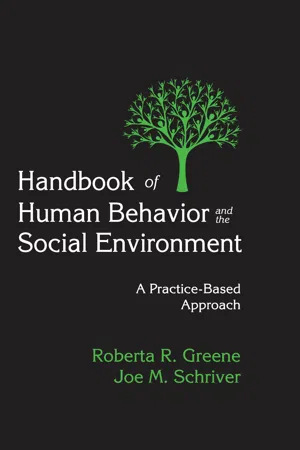Psychology
Social Diversity
Social diversity refers to the variety of social identities and experiences within a group or society, including differences in race, ethnicity, gender, sexual orientation, religion, socioeconomic status, and more. It encompasses the understanding and acceptance of these differences, as well as the promotion of inclusivity and equality. In psychology, social diversity is studied to understand its impact on individual behavior, attitudes, and well-being.
Written by Perlego with AI-assistance
Related key terms
8 Key excerpts on "Social Diversity"
- eBook - ePub
Theories of School Psychology
Critical Perspectives
- Kristy K. Kelly, S. Andrew Garbacz, Craig A. Albers(Authors)
- 2020(Publication Date)
- Routledge(Publisher)
2THEORETICAL FOUNDATIONS OF DIVERSITY IN SCHOOL PSYCHOLOGY
Markeda Newell, Prabha Kaundinya and Mayra GaonaDiversity is not simply about the experiences of members of selected traditionally disadvantaged groups or people who bring different values and cultures to new countries when they immigrate. Diversity affects and include us all.Jones, Dovidio, & Vietze (2014) , p. xviWhat theories guide the conceptualization of diversity in school psychological practice? To answer this question, we must first define diversity. Diversity refers to the range of different identities (e.g., age, race, gender, socio-economic status, language, religion, disability status, gender identity, sexual orientation, ethnicity, national origin, citizenship status) present within and between groups. Importantly, diversity is a collective term that refers to groups of people; diversity does not refer to one individual or one identity. It is important to understand this because oftentimes diversity can be applied too narrowly, which can be problematic. As Nunn (2008) explained, the term diversity has also been used restrictively to refer to racial differences alone. This view of diversity typically reflects a conflation of concepts of membership in a minoritized group with diversity. For example, a predominantly Black student population is not diverse when considering race alone but might be diverse because the group also includes Black students of different genders, socio-economic statuses, sexual orientations, disability statuses, or religions. Bringing clarity to the definition of diversity is important because it is a common misconception that a student population lacks diversity if there are very few or no racial minority students. This view of diversity typically occurs because people have conflated being a member of a minoritized group with being diverse - eBook - ePub
Managing Diversity and Inclusion
An International Perspective
- Jawad Syed, Mustafa Ozbilgin(Authors)
- 2019(Publication Date)
- SAGE Publications Ltd(Publisher)
In this chapter, we will explore the concept of diversity from a social and psychological perspective (i.e. the affect, behaviours and cognitions relating to diversity). More specifically, we will look to explore how feelings, thoughts, beliefs, intentions and goals are constructed and how they in turn influence the behaviours of individuals towards diverse social groups (such as ethnic minorities, women, individuals from varying social classes). By so doing, we aim to develop our understanding of the concept of diversity through historically linking it to equality. Of particular interest is understanding diversity within the workforce and exploring how individuals across different diversity categories (such as race, gender, age, class) could be disadvantaged as a result of belonging to these groups. Psychological processes such as prejudice, unconscious bias, stereotyping and microaggression that contribute to discriminatory attitudes and behaviours towards diverse individuals in and out of the workplace are explored. Next, we present the dominant underpinning social psychological theories of diversity (e.g. social identity theory, social categorisation theory, similarity–attraction theory and embedded intergroup relations theory) that help us to understand how differences in groups are created, managed and affected by workplace policies and practices, and their implications. The chapter concludes with an introduction to cultural diversity within an African context and explains how culture differences shape individual behaviour, influence intergroup relationships and affect thought and actions.What is ‘diversity’?
Scholars and practitioners have defined the term ‘diversity’ in a variety of ways. Nkomo and Cox (1996) reviewed the broad range of diversity research and looked at the various ways in which diversity has been conceptualised. They concluded that there were broadly two ways in which diversity has been defined – narrow and broad/expansive. While narrow definitions mainly focus on race, gender, religion, etc., broad or expansive definitions tend to look at both visible and non-visible characteristics and differences in individuals. Examples of narrow definitions include Cross et al. (1994: xxii), who defined diversity as focusing on issues of racism, sexism, heterosexism, classism, ableism and other forms of discrimination at the individual, identity group and systems levels. Similarly, Lai and Kleiner (2001: 14) define diversity as ‘not only formed by sex, but also by race, color, religion, and national origin’. Conversely, examples of broad/expansive definitions include Thomas (1991: 10), who defined diversity as ‘…everyone, it is not something that is defined by race or gender. It extends to age, personal and corporate background, education, function and personality…’. And Shackelford (2003: 53) noted that ‘the new definition of diversity - eBook - ePub
- Linda Gast, Anne Patmore(Authors)
- 2012(Publication Date)
- Jessica Kingsley Publishers(Publisher)
CHAPTER 1 Diversity in the Context of Current Social Work PracticeKey messagesIntroduction• Diversity is a broad subject, related to equal opportunities, anti-oppressive practice and anti-discriminatory practice.• Social workers need to understand their own prejudices, biases, stereotypes and opinions and how these may impact on practice.• In order to work effectively with the diverse range of service users, any discrimination and oppression which they may have experienced needs to be acknowledged.• Power impacts on how people experience the world, so is a crucial component of any social work relationship.Diversity is an important yet difficult area to talk and write about. It raises strong emotions in many people precisely because it touches on all of our lives and has personal resonances. Whatever we write as authors has the potential to be biased because of our genders, our racial backgrounds, our age, our abilities, our education and our perspectives. However, as well as the more obvious areas in which people have experienced discrimination, we have chosen to cover some broader differences, to extend thinking about difference. When the National Minimum Standards for Adoption (DfE 2011) were published, Standard 2, expressed as ‘Promoting a positive identity, potential and valuing diversity’, elicited anxiety that this would dilute the focus on areas traditionally associated with oppression or discrimination, yet it seems to offer a much more holistic and comprehensive appreciation of the complexity of individuals.This book seeks to explore racial, cultural and personal diversity from a number of different perspectives using a range of models, some of which are very familiar to the social care professions but some of which are not. It will explore personal biases which affect the way in which we perceive others and some of the values by which we make judgements about individual, family, group and community differences. It will then offer models for understanding diversity which, with practice, can positively influence the quality of interactions with service users. We intend for this book to be an opportunity to explore the big picture of diversity and to provide the reader with the knowledge and awareness needed to practice social work responsibly and effectively. Working from the starting point that diversity is ‘all the ways in which we differ’ (the approach taken by the authors) and ‘everybody is like all other people, like some other people, and like no other person’ (a concept explored by Kluckhohn and Murray 1948), diversity focuses particularly on the middle phrase – how we are like others and how we differ. - eBook - ePub
Human Behavior Theory
A Diversity Framework
- Roberta Greene(Author)
- 2017(Publication Date)
- Routledge(Publisher)
1 Social Work Practice Within a Diversity Framework Roberta R. Greene(Hamilton, [1940] 1951, pp. 206-207)The idea of cultural pluralism, the enrichment which comes from the acceptance and enjoyment of cultural differences, should increasingly affect all disciplines concerned with constructive human relationships.During the past 20 years, American society has become increasingly diverse. Although the United States has always been a multigroup society, in recent years the metaphor of America as a melting pot with its goal of homoge-nization has been challenged as never before. The debate is joined in the social and political arena by those holding an alternative vision: a multicultural society that supports a variety of ethnic group values and life-style choices.The United States has experienced, and will continue to experience, marked growth in the numbers of people who belong to diverse cultural groups. People have become increasingly aware of or have rediscovered their ethnic identity and cultural group membership. In addition, advocates for civil rights for minorities, women, and gays and lesbians have become more informed consumers of mental health services. The theories and practices for assessment, psychiatric diagnosis, and a range of mental health interventions have come under increasing attack for their gender, race, cultural, and social class bias. Hence, social work practitioners will undoubtedly need to prepare themselves to serve diverse client groups.These societal forces, combined with accompanying political factors such as increased participation of minorities in the political process, have profoundly affected social work education. As a result, educators have come to better appreciate the importance of teaching social work students within a diversity framework, and researchers are further examining how best to deliver culturally competent social work services. - eBook - ePub
Human Behavior Theory
A Diversity Framework
- Roberta R. Greene, Nancy Kropf(Authors)
- 2017(Publication Date)
- Routledge(Publisher)
1Defining Social Work Practice within a Diversity Framework Roberta R. Greene and Nancy P. Kropf(Sue, 2006, p. xvii)Social work theories, concepts, and practices are often rooted in and reflect the dominant values of the larger society. As a result, forms of treatment may represent cultural oppression and may reflect primarily a Eurocentric worldview.Culturally competent social work practice has expanded “to promote the full humanity of all voices which have been marginalized in our society.” (Hooyman, 1996, p. 20)This text discusses various approaches to the study of human diversity and of populations at risk for discrimination (Fellin, 2000). It also examines the extent to which these issues receive attention in the human behavior literature. The first chapter provides the historical background and content relevant to cross-cultural social work practice and defines major terms and assumptions. The following chapters explore how the particular assumptions of human behavior theories—psychoanalytic theory, psychodynamic/ego psychology theory, systems theory, symbolic interaction theory, feminist theory, constructionist theory, small group theory, an ecological perspective, and risk and resilience theory—have been used to guide cross-cultural social work practice. Micro-, mezzo-, and macrolevels of diversity issues are discussed.Introduction
During the twentieth century, various diverse constituencies became more active in political processes, advocating civil rights for minorities, women, and gays and lesbians, and becoming more informed consumers of mental health and social services. In the new millennium, American society will continue to become increasingly diverse, with a marked increase in the proportion of the population who belong to various ethnic and or cultural groups. From an identity perspective, people are becoming increasingly aware of or are rediscovering their ethnic and cultural roots. It is not unusual for people to find themselves working closely in industry, commerce, or services with people from diverse cultural backgrounds. In addition to the demographic changes that are taking place within the United States, the world is becoming more interdependent and connected as a result of technological advances and trade. - eBook - ePub
- Barbara Douglas, Ray Woolfe, Sheelagh Strawbridge, Elaine Kasket, Victoria Galbraith, Barbara Douglas, Ray Woolfe, Sheelagh Strawbridge, Elaine Kasket, Victoria Galbraith(Authors)
- 2016(Publication Date)
- SAGE Publications Ltd(Publisher)
12 Working with difference and diversitySimon ParrittIntroduction
The terms ‘diversity’ and ‘difference’ should not necessarily be viewed as problematic or the cause of conflict and difficulty, but be seen as positive and enriching. However, at an organisational and socio-political level, promoting diversity has become concerned with issues and policies addressing the experience of marginalised, disadvantaged and oppressed people and groups who face discrimination at a structural and personal level. These policies aim to redress the power imbalance and bring minorities within the core of an organisation as citizens, employees, consumers and users. However, the emphasis in this chapter will be on how we, as counselling psychologists, can actively address the individual’s experience of being different or from a diverse group within our work and individual practice, and acknowledging that the therapeutic relationship does not take place within a cultural or political vacuum. This is especially relevant in today’s world where ‘[h]uman migration and immigration connected to political oppression, economics, poverty, and the need for employment bring challenges for everyone involved’ (Gerstein et al., 2011).The aim of this chapter will be to bring together some aspects and issues of difference and diversity and highlight that although oppressed and minority groups are, by their very nature, distinct and uniquely different, they share much in relation to their experience of the dominant culture and ideology and the underlying issues that confront them. Further, the chapter will explore how counselling psychology may be uniquely placed to meet this challenge because of its philosophical underpinning and how this can facilitate working effectively to empower those who are often silent, quiet, ignored or ‘voiceless’, not just at a socio-cultural level but also in relation to therapy itself, as they are often ‘positioned outside the masculine cultural metaphors and conventional theoretical epistemologies of counselling, psychology and psychotherapy’ (Moodley, 2009: 299). Moodley (2009) suggests that the history of psychotherapy sits within a Eurocentric, ethnocentric, individualistic and masculine cultural discourse, which places minority groups in an invidious position where they can only articulate their experience with a narrative embedded in a kind of cultural hegemony. The aim here, then, is examine how to build upon counselling psychology practice in order to address some of these barriers. - eBook - ePub
Diversity in Organizations
New Perspectives for a Changing Workplace
- Martin M Chemers, Stuart Oskamp, Mark Constanzo(Authors)
- 1995(Publication Date)
- SAGE Publications, Inc(Publisher)
Based on lessons learned from demographic research, we conclude that the issue of demography is much more complex than suggested by most previous research. Demographic attributes are multiple and interdependent, with potentially differing results depending upon the level of analysis. In addition, organizations are dynamic social systems. Results from snapshot demographic research may be nonconclusive and nongeneralizable. Further, the preliminary results from this stream of research suggest that a demographic attribute may mean different things to different people and that its meaning may be affected by situational cues.In essence, demography is about the relationship between a particular context and the demographic elements within it. Similarly, diversity is about the experience of being different from others in a specific setting that has a particular set of social structural features. Therefore analysis of specific demographic effects or of organizational diversity issues in general must incorporate the influence of the context in situ. The organization and its associated cultural attributes represent a context variable that may be particularly relevant for understanding the dynamics of demographic diversity in organizations.We propose that the organization itself is a social category that comprises a set of unique cultural attributes conveying different meanings to different individuals. The organization as a cultural entity may be a source of social identity for some individuals. As a cultural entity, it may also modify the meaning or salience of other demographic attributes as well as the importance of these demographic patterns to individuals and groups. In the next section, we use the culture metaphor and two of the three perspectives proposed by Martin (1992) for analyzing an organization’s culture, to illustrate how analysis and understanding of demographic effects may change depending on the cultural manifestations of an organization.Understanding Demographic Diversity in Organizations: The Role of the Organization and Organizational CulturePolitical scientist Robert Presthus (1978) suggested that we now live in an “organizational society,” surrounded by organizations of all sorts. The employed population in particular spend two thirds of their waking hours in organizations. Organizations, however, are more than places where people work. For some people, organizations are a source of self-identity and emotional support. They are a “cultural phenomenon” in themselves, argued Morgan (1986)—“mini-societies that have their own distinctive patterns of culture and subculture” (p. 112). Martin (1992) elaborated further: - eBook - ePub
Handbook of Human Behavior and the Social Environment
A Practice-Based Approach
- Roberta R. Greene, Joe Schriver(Authors)
- 2017(Publication Date)
- Routledge(Publisher)
3Human Behavior and the Social Environment: Engaging Diversity and Difference in Practice- This chapter describes the use of human behavior and the social environment theory to support social workers in engaging diversity and difference in practice. The theory and models presented are guided by the ecological systems perspective and symbolic interaction theory. These are contrasted with Africentric concepts intended to inform micro- and macropractice with individuals, families, groups, organizations, and communities. Major concepts include power, oppression, and identity formation. Strategies to try and eliminate personal bias and to promote human rights are discussed.
Chapter 2 described the reciprocal influence of the person and environment—"the nested context of social competence" (Walsh 1998, 12). This chapter expands the discussion by turning attention to how culture and diversity "characterize and shape the human experience" (Council on Social Work Education [CSWE] 2015, 4).The chapter is divided into two sections. It first explores how larger-scale systems— political, economic, educational, and legal—may either be supportive influences in people's lives or oppress and marginalize people by limiting access to services and human rights. It then discusses how exclusionary policies and hostile environments affect identity formation, sometimes contributing to feelings of alienation. At the same time, it contrasts ways in which people's cultural heritage can positively influence well-being.Models that help social workers conduct cross-cultural practice and combat bigotry and prejudice are also provided. These models stem from a theoretical base that incorporates the values of people of color (Schiele 1996). The purpose is to provide human behavior and the social environment theory for social work practice with diverse constituencies, "recognizing, supporting, and building on the strengths and resiliency of all human beings" (CSWE 2015, 10).
Index pages curate the most relevant extracts from our library of academic textbooks. They’ve been created using an in-house natural language model (NLM), each adding context and meaning to key research topics.

